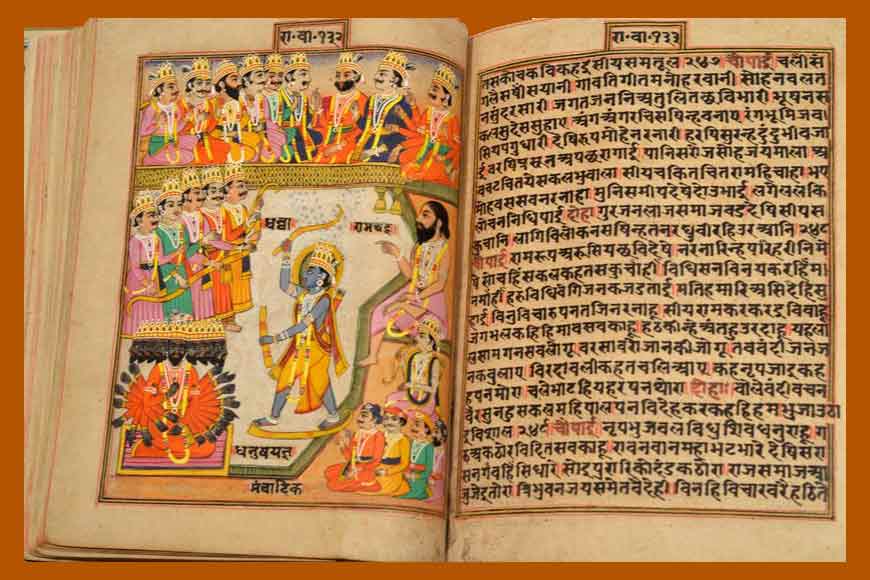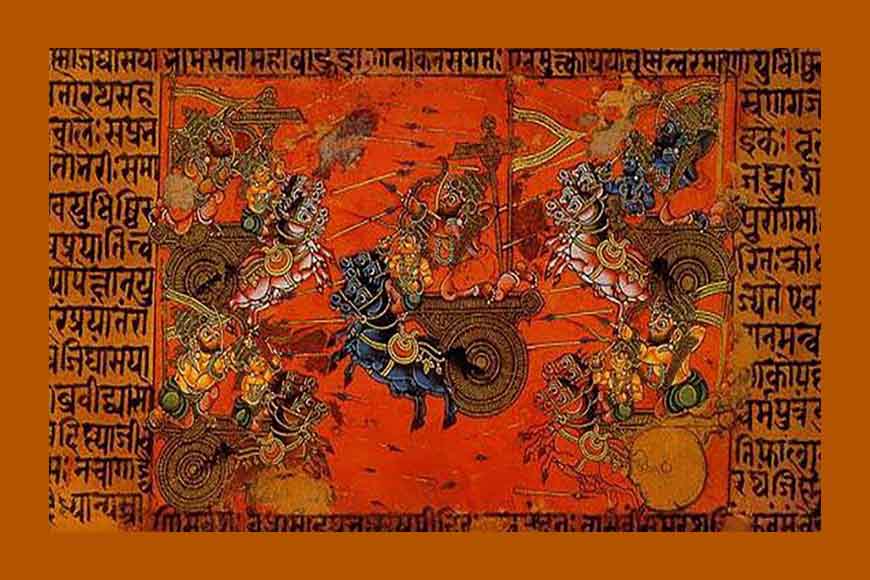The Ramcharit Manas manuscript that travelled from Mahisadal to Kolkata

Representative image
An ancient handwritten manuscript with multi-coloured pictures of Tulsidas’ Ramayana Ramcharit Manas, owned by the royal family of Mahisadal under Tamluk subdivision of Midnapore district has become an interesting subject of discussion among the art historians of today. The language of the manuscript is close to the Abadi Sanskrit dialect prevailing in Western Bihar and Uttar Pradesh and although the script is written in Nagri and the pictures displayed in the manuscript are undoubtedly related to the traditional forms of Folk Painting. This manuscript was collected from Murshidabad by the Ashutosh Museum which held a collection of various exhibitions of fine arts gathered by the Calcutta University.
Before that the manuscript was preserved in a Vaishnava Institute of Sadhakbag under Jiagunj of Murshidabad which had been established by Mastara Aulia of the Ramanuj community. The manuscript was collected in 1942 from Ramdas Aulia, the then head of the institute by Debaprasad Ghosh, the founder-director of Ashutosh Museum. A distinctive feature of this manuscript was that it displayed a picture from the Ramayana on each page, below which the main text was written in Nagri. The manuscript comprised of 343 pages reproducing all 7 chapters of Tulsidas’ Ramayana, a phenomenon which had probably prompted Professor Ghosh to comment that this was the only ancient manuscript on the Ramayana with coloured pictures found in West Bengal. In the handwritten manuscripts of those days, it was a common practice to include the name of the owner as well as the transcriber in the concluding stanza.
In this particular exhibit, it is written that a Brahmin by the name of Shri Iccharam Mishra had composed this Ramayana manuscript for the reading of Rani Janki of Kamalpur village under Mahisadal division. The manuscript also states the various dates on which each chapter had been written. It is seen that the transcription of the manuscript was commenced in 1180 and completed in 1182 of the Bengali calendar year. In other words, the writing of the last chapter known as the Lanka Kanda was concluded in or around February- March of AD 1775. Although the name of the transcriber has been stated, the names of the painters who had drawn the pictures have not been mentioned anywhere. This leads us to conclude that the transcriber Iccharam Mishra might have drawn the paintings himself. From what is written in the concluding stanza of the manuscript, it can be deduced that it had been composed at Kamalpur for the reading of Rani Janki, childless widow of Ananda Upadhyay, the erstwhile landlord of Mahisadal. Even today a group of villages exist under a police station named Kamalpur and it is reasonable to presume that the Kamalpur mentioned in the manuscript was a part of the same group and it was there that the Upadhyay family had their ancient palace at one time. That Rani Janki was a religious minded lady is evident from the fact that apart from this Ramayana manuscript, her name is inscribed as the founder-patron on a number of temples which she had built in several villages within her own zamindari namely Nandigram, Rambag and Deulpota in addition to a tall Navratna Temple for the worship of Gopal within her principal domain.
Because her origin was in Uttar Pradesh, she was devoted to Tulsidas’ Ramayana and had taken a lot of pains in getting this manuscript composed by transcribers and painters at a considerable cost. Once the origin of the manuscript had been discovered, the next question that arose was how it found its way to the monastery of Sadhak Bag. In his book The History of Nandigram, Adhar Chandra Ghatak had stated:
“During the tenure of Bharat Das Aulia, the head of Sadhak Bag Institute of Murshidabad in 18th century AD, a branch monastery was set up in Kalicharan under Gumandar division. Kalicharan village controlled the place of pilgrimage at Sagar where the annual Gangasagar fair used to be held. Gouri Ram Das Aulia, a disciple of the institute used to arrive at the hermitage of Kalicharan on the last day of the month of Poush in the Bnegali calendar for visiting Gangasagar and he continued to stay there till the end of Chaitra.”
 Representative image
Representative image
As Kalicharan was located under Nandigram Police Station, which fell under the zamindari of Mahisadal, the branch of Sadhak Bag Institute set up there did receive the patronage and support of the Royal Family of Mahisadal and it is also reasonable to presume that the members of this family eventually became the disciples of this institute. Due to the absence of legal successors after the death of Rani Janki, the ownership of the zamindari passed on to the Garg family. It is heard that the latter family had also set up amicable links with the Sadhak Bag Institute. When an ancient chariot belonging to the institute had been badly damaged by fire, it had been rebuilt in 1920 with the financial support of the then zamindars of Mahisadal, Satish Prasad Garg and Gopal Prasad Garg. This goes to prove that cordial links had been maintained by the Sadhak Bag Institute with the Garg family. Hence this valuable manuscript composed at the behest of Rani Janki had been gifted after her death by the Garg family to the institute and was eventually brought from Murshidabad to Kolkata and included in the collections of Ashutosh Museum. It was only because the name of Rani Janki of Kamalpur had been mentioned in the last stanza of the manuscript that it was possible to trace its successive change of hands from Mahisadal to Murshidabad and then to Kolkata.
(Adapted from Folk Art of West Bengal and the Artist Community by Tarapada Santra)









